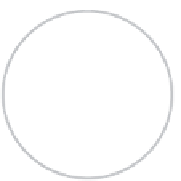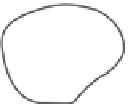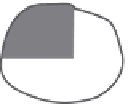Biomedical Engineering Reference
In-Depth Information
Binocular
visual field
Monocular portion
of visual field
Monocular portion
of visual field
Left visual
field
Right visual
field
Left monocular visual field
Right monocular visual field
Left retina
Right retina
S
Superior (S)
S
S
T
Temporal
(T)
Nasal
(N)
T
N
T
Fixation
point
Fovea
Inferior (I)
I
I
I
FIgUre 10.8
(See color insert.)
Projection of the visual fields onto the left and right retinas. Projection of an image onto the
surface of the retina. The passage of light rays through the optical elements of the eye results in images that are
inverted and left-right reversed on the retinal surface. Retinal quadrants and their relation to the organization
of monocular and binocular visual fields as viewed from the back surface of the eyes. Vertical and horizontal
lines drawn through the center of the fovea define retinal quadrants (bottom). Comparable lines drawn through
the point of fixation define visual field quadrants (center). Color coding illustrates corresponding retinal and
visual field quadrants. The overlap of the two monocular visual fields is shown at the top.
and so on. All of these pieces of information are still separate and require further process-
ing in area 18 or V2, where the single elements are united to build up the perception of
the object. One part of the fibers coming from area 18 or V2 moves toward the temporal
cortex, where further analysis of the superior characteristics of the visual information
is carried out. All of those lines, with their own information on length, color, topologic
relations, etc., are classified with a verbal tag and memorized. In this moment, the “What
is it?” is identified. Other fibers proceed toward the parietal cortex, where spatial visual
information is processed, allowing detection of where the object is in relation to us. In
conclusion, these two pieces of information must go together to form one perception so
that we can perceive, localize, and recognize the object. This will make us interact with
the object itself, grasping it, manipulating it, using it, and having an immediate feedback
on the quality of our actions. This further and crucial integration occurs at the prefrontal
and frontal cortex level (Hubel 1995).
This concise overview of the visual process, which is not at all complete, is aimed at
underlining the complexity of what happens during one simple gaze. Later in this work,
the importance of every point discussed will be analyzed to understand some of the
responses of our patients and to allow us to be able to adapt suitable instruments to every
single patient.





















































